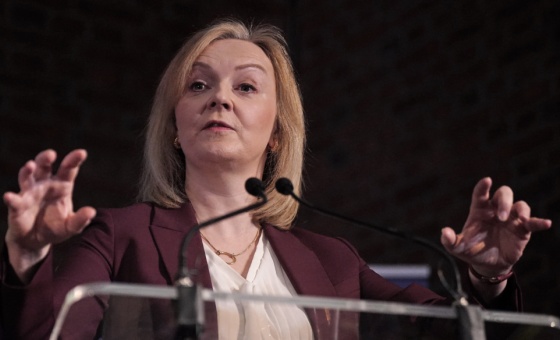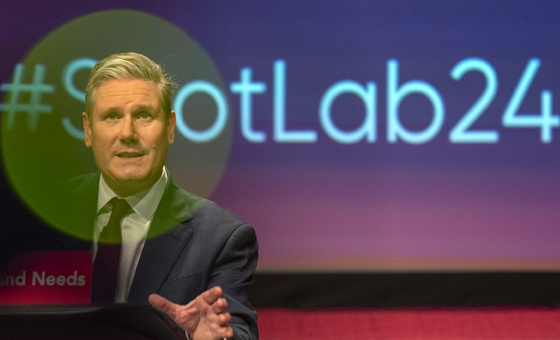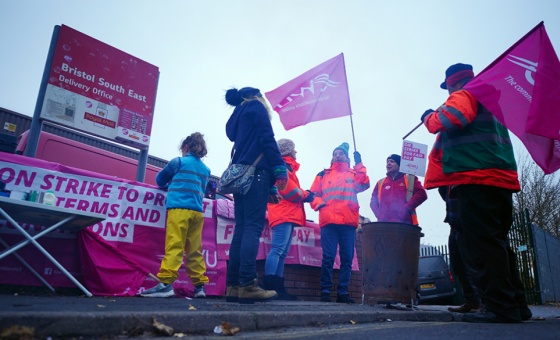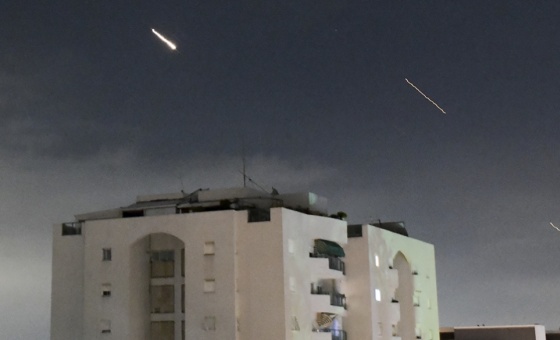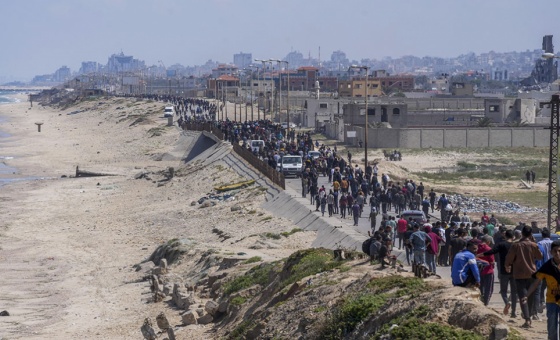This is the last article you can read this month
You can read more article this month
You can read more articles this month
Sorry your limit is up for this month
Reset on:
Please help support the Morning Star by subscribing here
Thirty years ago this week, the US Air Force (USAF) started deploying a new generation of nuclear weapons at RAF Greenham Common.
As the weapons were flown in over the heads of the Greenham Common Women's Peace Camp, thousands of women protested by pulling the perimeter fence down. On the TV news some women were shown crying.
Government and cold war commentators gloated that "the Greenham women have failed." Dispirited, some women left Greenham.
But more arrived from all over the world, full of anger and non-violent determination to prevent these weapons from being exercised or used.
With Cruisewatch, a community-based network with its roots among Greenham women, we disrupted every nuclear convoy and war game.
And just four difficult years later we had the last laugh, as the Conservative government scrambled unsuccessfully to prevent presidents Reagan and Gorbachov from agreeing to ban and eliminate all the cruise, Pershing and SS20 missiles the US and Soviet Union had deployed in Europe.
A few years later we celebrated again with supporters from the local town, Newbury, as the USAF left this flagship nuclear base and it was restored to common land.
Where soldiers and dogs once patrolled and Greenham women were arrested and beaten for cutting fences and painting military vehicles, children and dogs now play.
Exmoor ponies now graze in front of the empty silos that once housed 96 nuclear missiles and their huge delivery vehicles, known as "transporter-erector launchers."
We danced on those silos on New Year's Day 1983. It was the start of an extraordinary year of intense political mobilisation and non-violent actions against nuclear weapons and the threats of war.
While awaiting trial for occupying the silos, we organised a suffragette-style "rush on Parliament" with banners and arguments and a die-in that blocked vice-president George HW Bush's car as he visited Margaret Thatcher in Downing Street.
As one of 20 women on the electoral roll and named in an injunction to stay away from Greenham, I was "produced" from Holloway Prison - 14 days for "breach of the peace" - to the High Court where hundreds of women had signed affidavits promising to leave their jobs and families and take the place of any of the camp's residents if we were forced to leave Greenham.
Greenham Women Everywhere was born - carrying our feminist, anti-militarist, non-violent message around the world. Working in towns and communities as well as participating in the camp, Greenham women organised peace camps all over the world for Women's International Day for Disarmament, held on May 24, and mobilised a succession of blockades and other actions at Greenham.
The High Court injuntion against us failed, but it gave us the idea to take out an injunction against president Reagan and the joint chiefs of staff to stop them deployment cruise missiles in Europe.
So in November 1983 I was among 13 Greenham plaintiffs in a New York court arguing against Rudi Giuliani, then Reagan's defence attorney.
Though we failed in the US courts, this legal initiative with the Centre for Constitutional Rights raised political awareness in the US and encouraged women to organise one-day peace camps at 102 US bases in Britain.
It also developed legal arguments against the use and threat of use of nuclear weapons that were taken to the International Court of Justice a decade later.
A month after the cruise missiles were flown in, over 50,000 women encircled Greenham with mirrors and boltcutters, showing our non-violent but very active determination to eliminate these weapons before they eliminated us.
Miles of fence were taken down as soldiers tried to stop us from running onto the silos again.
Asked about base security, defence secretary Michael Heseltine pompously declared that though "these women" kept getting into the base, we couldn't reach any "sensitive area."
So just after Christmas three of us proved him wrong. We crawled through five rows of fencing and barbed wire under the noses of MoD police, British squaddies and armed US airmen, and then climbed and occupied the air traffic control tower for over five hours, where we waved a "Peace on Earth" bedsheet and read classified documents and manuals for dealing with nuclear, chemical and biological weapons "incidents."
Local emergency services were not to be informed until later for fear of spreading "panic."
The Greenham peace camp, founded by Welsh women in September 1981, developed into a major feminist hub of the resurgent anti-nuclear movement.
Scratch the surface of the lives of many politically engaged women today, and you will generally find Greenham in one form or another. So many participated - or, depending on their age, had mothers or someone close to them who were inspired by Greenham.
Yet Greenham is far better remembered by international feminist and peace movements than in Britain.
Once Reagan and Gorbachov had signed the Intermediate-Range Nuclear Forces (INF) Treaty on December 8 1987, patriarchal historians seemed to buy into the Tory PR machine's narrative, where Thatcher and Heseltine claimed credit for "negotiations from strength" - concealing their unsuccessful efforts to stop the US from leaving Greenham.
Thirty years on, another Tory government is trying to foist a new generation of Trident onto the British people, with a price tag of £100 billion.
Trident replacement plans are ridiculous, unnecessary and immoral - our security would be far better served by investing in the NHS, education, sustainable energy production and tackling environmental problems.
Greenham was very successful, but it's pointless to criticise today's peace movement for not blocking the streets and bases with hundreds of thousands of protesters.
Greenham developed to deal with the specific conditions of the 1980s. To be effective nowadays, campaigners have to use different means and methods, including social media.
Greenham women contended with vigilante and police violence, arrests, evictions, imprisonments and other problems.
Protesters now face more intrusive surveillance, draconian terrorism laws, and an austerity agenda that especially restricts and disempowers women and young people - so today's movement needs to adapt our means and actions.
The key lessons I learnt from Greenham and my subsequent campaigning to halt nuclear testing were that behind every government treaty restricting weapons is a strong and committed campaign by civil society.
We need to back international demands for a nuclear ban treaty as well as working with national and local groups and politicians to scrap Trident.
That is what we are now building, working on all fronts. Politically effective strategies involve both non-violent resistance, putting direct pressure on contractors and military bases, and political arguments directed towards governments and leaders.
In addition to undertaking a New Ban the Bomb tour with CND, I'm part of the core group of the recently launched grass-roots direct action campaign called Action AWE (Atomic Weapons Eradication), which is mobilising citizens' groups to oppose Trident at Aldermaston and Burghfield.
For women who want a taste of feminist camping à la Greenham, the Aldermaston Women's Peace Camp - which we founded in 1985 - still camps, meets and plots next to the Citadel Gate at Aldermaston (A340) on the second weekend of every month, with ongoing support from CND and Women in Black, which brings a feminist analysis to weekly vigils and ongoing work against violence and militarism, including nuclear weapons.
At the same time, I work with the International Campaign to Abolish Nuclear Weapons and over 120 governments to highlight the humanitarian consequences of nuclear weapons and pave the way for a global nuclear ban treaty that will comprehensively prohibit the use, deployment, production, stockpiling and transporting of nuclear weapons and require their total elimination as quickly, safely and securely as possible.
When we achieve this treaty - as we assuredly will, just as we achieved the INF Treaty in 1987, the Comprehensive Nuclear Test Ban Treaty in 1996 and the Landmines Ban in 1997 - credit will no doubt be claimed by presidents and prime ministers.
So what? Like the tribute paid to Greenham women by Gorbachov, the treaty will make the world safer because of the hard work and persistence of the activists who refused to give up and who created the conditions and pressures that make such disarmament agreements possible.
Rebecca Johnson is executive director of the Acronym Institute and vice-president of CND. She lived at the women's peace camp at Greenham from 1982 to 1987.


